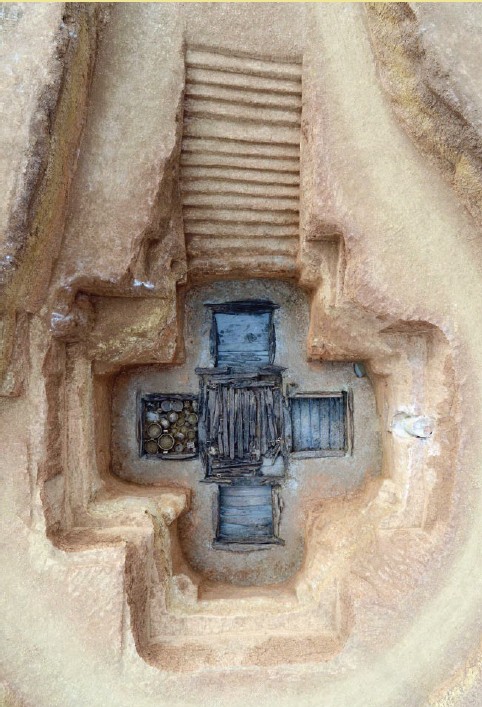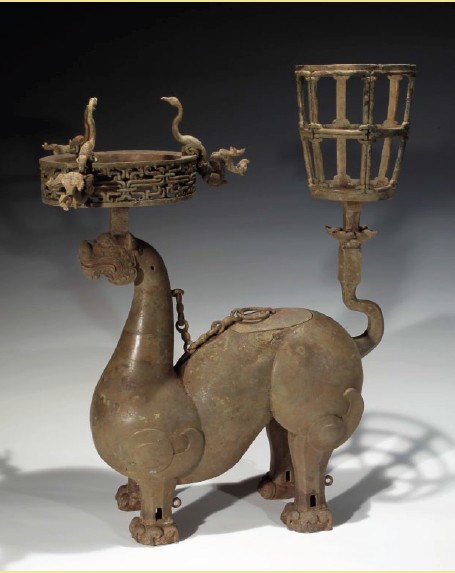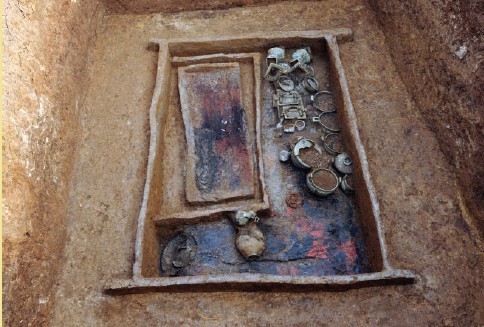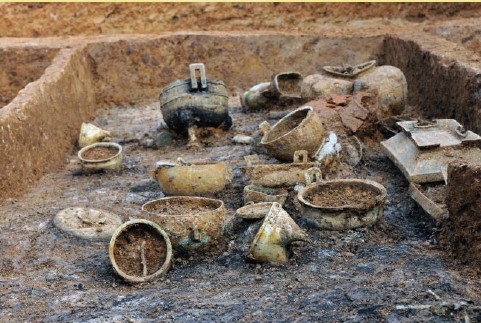New Discoveries of Zeng Kingdom’s Cemetery from Eastern Zhou period at Wenfengta, Hubei Province
From:Chinese Archaeology NetWriter:Date:2014-01-16
The Wenfengta Cemetery is located at the Wenfengta Community in Suizhou. From June 2011 to May 2012 four tombs dubbed M4, M5, M6, and M7 have been uncovered by Hubei Provincial Archaeological Institute, confirming the site as a remain from late Spring-Autumn period to Eastern Han dynasty. In June 2012 the newly vacated places in the cemetery have been surveyed and probed in a large scale. From September 2012 to January 2013 totally 66 tombs including 54 pit tombs, 11 brick-chamber tombs have been uncovered. The pit tombs includes 7 large-sized, 6 middle sized and 21 small sized tombs. All large sized tombs have been rubbed. In addition, 2 horse-and-chariot pits and 1 horse pit have been found.

Plan of tomb M18
Tomb M18 in the south is the largest one. It has a cruciform plan in a north-south direction. The tomb has a shaft earth pit containing outer wooden coffins. The slanting passage toward south remains 15 steps. At its east, north and west sides there is respectively a rectangular accessory burial pit with each side measuring 2 m long. The opening of the tomb is larger than its bottom where remain 3 steps. The opening is 16.35 m long, 15.35 m wide and 8.8 m deep. At the 8 corners each reserves a semicircular earthen structure to strengthen the tomb’s walls. The bottom of the tomb is 12.7 m long and 11.37 m wide. The east part of the passage overlaps on the tomb M69 and the middle part of the west wall is overlapped by a today’s well. The wooden outer coffin consist supporting woods on the bottom, outer coffin and inner coffin, total in five chambers with the central one containing another inner coffin.

Bronze jian container from M18

bronze lamp from tomb M18
The supporting woods under the outer coffin are placed in vertical or horizontal directions according to different chambers. There are 10 woods with each two forming one group. The central chamber is larger and the bottom consists more wood planks than that of other chambers. The second outer coffin in this chamber is in disorder, remaining 3.2 m long and 2.6 m wide. The inner coffin is placed in the east of the central chamber, possibly containing a second inner coffin. The bottom of the inner coffin measures 2.7 m long and 1.58 m wide. The tomb M18 contains two outer coffins and two inner coffins, possibly all made of wood. The skeletons inside are completely degenerated. Presumably the head is towards southeast. Burial objects in the east chamber are mostly bronze wares. There are some lacquers. At its southeast corner remains one bronze lamp with exquisite design.

plan of tomb M29
The pit dubbed CH2 in rectangular shape is filled with brown and grayish earth, which is very compact but without any objects as well as any trance of being rammed. Under the compact earth layer there are buried remains of horse and chariots, including a chariot and 4 horses. The horse bones placed in the west of the pit are in very poor condition of preservation, remaining only traces. There are two at the front lying in the same attitude and two at the back lying back to back. All of them lie on one side, with four legs bent and heads toward west, which could be placed inside the tomb after being killed. The chariot is in poor condition, remaining only parts of the shafts, wheels and traces of the cabin. According to analysis the pit CH2 should be a part of the tomb M29.

plan of tomb M36
The excavation yields totally 1,027 objects made of bronze, ceramic, lacquer, leather, jade and stone. There are 577 bronze objects including Ding tripod, Fu container, Gui vessel, square pots, Fou container, Yan vessel, Jian vessel, plates and Yi vessel. Some of them bear inscriptions as “Zeng”, “Zeng Zi” and “Zeng Gong Zi”. All ceramics are broken, which mostly are imitations of bronze ritual wares. Judged from shapes of burial objects and inscriptions on them, the tombs could be dated back to from middle Spring-and-Autumn period to the middle late of Warring States period. Most tombs from middle Spring-and-Autumn period to middle Warring States period could be Zeng Kingdom remains. Their occupants are mainly nobles of the Zeng kingdom. In addition, some Chu Kingdom tombs dating to late Warring States period have also been found.

bronze yi vessel from tomb M35
The academic significances of the findings go as following: Firstly, the excavation for the first time uncovers a group of Zeng Kingdom tombs from middle late Spring-and-Autumn period, yielding amounts of inscribed bronzes, which are of great importance for the identification of the tombs and their occupants. Secondly, the chariot-and-horse pit is the first find in Suizhou area, providing important evidence for analyzing the funerary murder system of Zeng Kingdom. Thirdly, the cruciform plan of the tomb is also the first find, enriching the types of Eastern Zhou tombs in Hubei province. Fourthly, the inscriptions provide possibilities to resolve the long-standing question about Sui and Zeng kingdoms and their bronzes. Finally, the cemetery has very high value for uncovering the Zeng Kingdom’s history. Tombs of Zeng and Chu kingdoms provide important clue to ascertain the date that the Chu conquered the Zeng. (Translator: Tong Tao)

